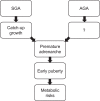The Association of Accelerated Early Growth, Timing of Puberty, and Metabolic Consequences in Children
- PMID: 37029976
- PMCID: PMC10686698
- DOI: 10.1210/clinem/dgad202
The Association of Accelerated Early Growth, Timing of Puberty, and Metabolic Consequences in Children
Abstract
Accelerated early growth and early timing of puberty or pubertal variant have been noticed as risk factors for metabolic syndrome, more frequently observed in children born small for gestational age (SGA) or children with premature adrenarche (PA). Children with SGA, especially if they make an accelerated catch-up growth in early life, carry a higher risk for long-term metabolic consequences, such as type 2 diabetes, insulin resistance, and cardiovascular diseases. Furthermore, multiple studies support that these children, either born SGA or with a history of PA, may have earlier pubertal timing, which is also associated with various metabolic risks. This review aims to summarize the recent studies investigating the association between early infantile growth, the timing of puberty, and metabolic risks to expand our knowledge and gain more insight into the underlying pathophysiology.
Keywords: SGA; adrenal; growth; infancy; insulin resistance; puberty.
© The Author(s) 2023. Published by Oxford University Press on behalf of the Endocrine Society. All rights reserved. For permissions, please e-mail: journals.permissions@oup.com.
Figures
Similar articles
-
[Postnatal consequences of intrauterine development: pubertal development in children born small for gestational age].Klin Padiatr. 2008 Jan-Feb;220(1):10-5. doi: 10.1055/s-2007-971046. Klin Padiatr. 2008. PMID: 18172828 Review. German.
-
IUGR: Genetic influences, metabolic problems, environmental associations/triggers, current and future management.Best Pract Res Clin Endocrinol Metab. 2019 Jun;33(3):101260. doi: 10.1016/j.beem.2019.01.001. Epub 2019 Jan 22. Best Pract Res Clin Endocrinol Metab. 2019. PMID: 30709755 Review.
-
Catch-Up Growth as a Risk Factor for Rapid Weight Gain, Earlier Menarche and Earlier Pubertal Growth Spurt in Girls Born Small for Gestational Age (SGA)-A Longitudinal Study.Int J Environ Res Public Health. 2022 Dec 14;19(24):16808. doi: 10.3390/ijerph192416808. Int J Environ Res Public Health. 2022. PMID: 36554686 Free PMC article.
-
Puberty in children born small for gestational age.Horm Res Paediatr. 2013;80(2):69-77. doi: 10.1159/000353759. Epub 2013 Jul 26. Horm Res Paediatr. 2013. PMID: 23899516 Review.
-
Body mass index at the presentation of premature adrenarche is associated with components of metabolic syndrome at puberty.Eur J Pediatr. 2018 Nov;177(11):1593-1601. doi: 10.1007/s00431-018-3211-1. Epub 2018 Jul 28. Eur J Pediatr. 2018. PMID: 30056577
Cited by
-
The Ongoing Impact of COVID-19 on Pediatric Obesity.Pediatr Rep. 2024 Feb 2;16(1):135-150. doi: 10.3390/pediatric16010013. Pediatr Rep. 2024. PMID: 38391001 Free PMC article. Review.
-
Dynamic influence of maternal education on height among Chinese children aged 0-18 years.SSM Popul Health. 2024 Apr 23;26:101672. doi: 10.1016/j.ssmph.2024.101672. eCollection 2024 Jun. SSM Popul Health. 2024. PMID: 38708407 Free PMC article.
-
Accelerated Early Childhood Growth Is Associated With the Development of Earlier Adrenarche and Puberty.J Endocr Soc. 2024 Feb 13;8(4):bvae026. doi: 10.1210/jendso/bvae026. eCollection 2024 Feb 19. J Endocr Soc. 2024. PMID: 38425434 Free PMC article.
-
Lipid Profile and Triglyceride-Glucose Index (TyG) Alterations in a Single-Center Cohort of Children Diagnosed with Central Precocious Puberty.Children (Basel). 2024 May 25;11(6):639. doi: 10.3390/children11060639. Children (Basel). 2024. PMID: 38929219 Free PMC article.
References
-
- Nordman H, Jääskeläinen J, Voutilainen R. Birth size as a determinant of cardiometabolic risk factors in children. Horm Res Paediatr. 2020;93(3):144‐153. - PubMed
-
- Peeters S, Declerck K, Thomas M, et al. ; WES-BESPEED study group . DNA methylation profiling and genomic analysis in 20 children with short stature who were born small for gestational age. J Clin Endocrinol Metab. 2020;105(12):e4730‐e4741. - PubMed
Publication types
MeSH terms
LinkOut - more resources
Full Text Sources
Medical


